The Arc Fault Detection Devices Market is estimated to be valued at USD 156.4 million in 2025 and is projected to reach USD 356.9 million by 2035, registering a compound annual growth rate (CAGR) of 8.6% over the forecast period.
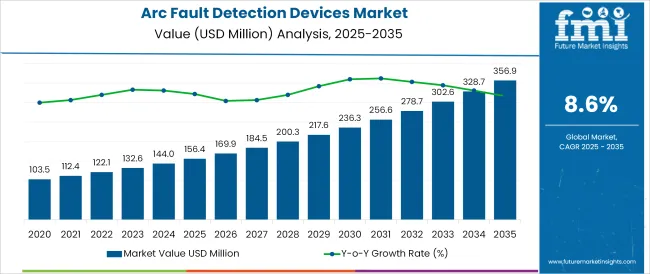
The arc fault detection devices market is witnessing strong momentum, largely driven by growing concerns over electrical safety and a rising number of fire incidents linked to arc faults. Increased implementation of stringent building codes and electrical safety regulations across residential and commercial infrastructure has significantly boosted the demand for AFDDs.
Governments and regulatory bodies in both developed and emerging economies are enforcing updated compliance norms that mandate the inclusion of these devices in new constructions and retrofitting projects. Manufacturers are increasingly focusing on compact cost-effective, and modular designs to support wider market adoption, while innovation in smart and IoT-enabled AFDDs is creating avenues for enhanced diagnostics, remote monitoring, and preventive maintenance
The rising electrification rate in developing regions combined with smart city initiatives, is also fostering long-term demand. These developments, coupled with strong support from insurance and risk mitigation standards, are paving the way for continuous market growth and diversification across application and industry verticals
The market is segmented by Type and Applications and region. By Type, the market is divided into 1 Module, 2 Module, 3 Module, and 4 Module. In terms of Applications, the market is classified into Residential, Business, and Industrial. Regionally, the market is classified into North America, Latin America, Western Europe, Eastern Europe, Balkan & Baltic Countries, Russia & Belarus, Central Asia, East Asia, South Asia & Pacific, and the Middle East & Africa.
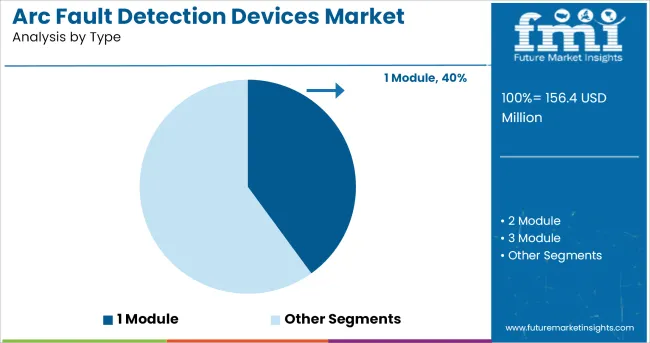
When analysed by type, the 1 module segment is projected to hold a 40.0% revenue share of the overall arc fault detection devices market in 2025, making it the leading segment. This leadership is attributed to the segment’s compact design and ease of integration with existing circuit protection infrastructure, which makes it highly favorable for both new installations and retrofitting in space-constrained environments.
One of the key growth drivers for this segment has been its compatibility with standard distribution boards and its ability to combine arc fault detection with other protective features such as overload and short-circuit protection. The convenience of plug-and-play configuration and lower installation time further enhances its adoption across residential and commercial settings.
In addition, the improved reliability, reduced nuisance tripping, and enhanced energy efficiency associated with advanced 1 module devices have made them a preferred choice among installers and electrical contractors, contributing to the sustained dominance of this segment.
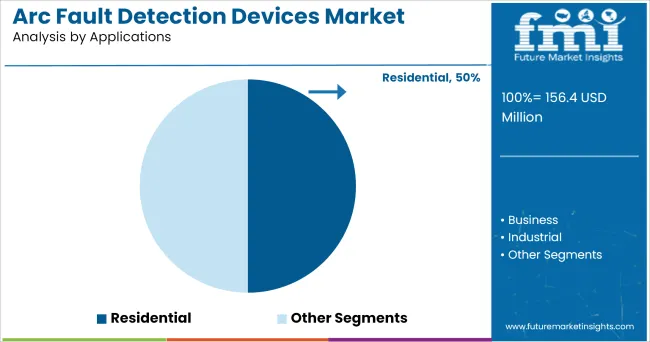
In terms of application, the residential segment is expected to account for 50.0% of the total arc fault detection devices market revenue in 2025, positioning it as the leading application category. This prominence has been driven by growing awareness about electrical fire hazards in households and the increasing adoption of stringent electrical codes that mandate arc fault protection in living spaces.
Residential developers and homeowners are placing greater emphasis on preventive safety measures, supported by incentives and enforcement from regulatory authorities. Additionally, the rising demand for smart homes has created opportunities for integration of AFDDs with home automation and remote monitoring systems. The affordability of compact residential units and simplified installation processes have further accelerated market penetration
As governments continue to push for higher safety standards in housing and urban infrastructure, particularly in high-density urban regions, the residential segment is expected to maintain its leadership in the coming years.
Broken wires, crushed cables, loose connections and worn insulation causes hidden arc faults in an electrical circuit. With the help of arc fault circuit interrupter, the faulty circuit can be isolated by detecting the Arc fault.
These faults occur in hidden places like inside walls, damaged cables, outlet sockets and loose connection. The circuit breaker AFDD cuts the electricity supply automatically and prevent the electrical arcs from reaching temperature where fire can take place. Such benefits are contributing to the growth of arc fault detection devices.
These Devices are capable of finding a difference between normal and dangerous Arcs. The electrical arcs in motor-driven vacuum cleaners, furnace motors and light switches can be analyzed by monitoring circuits. These devices are able to sense hundreds of different operating conditions. Such factors are driving the demand of arc fault detection devices.
There is an increase in the demand of arc fault detection devices in residential, business and industrial applications. Especially businesses are installing these devices in consumer units to provide protection from electrical arcs. Hotels have premises with sleeping accommodation and there is an increased risk of fire. In such cases, hotels are adopting these devices to protect themselves.
Residential homes are also moving towards arc fault circuit interrupter for safety factors like property or items with high sentimental value, save a life and others. These devices are available at low cost and adopted by residential homes for lifetime. Such trends will help the arc fault detection devices to grow in upcoming years.
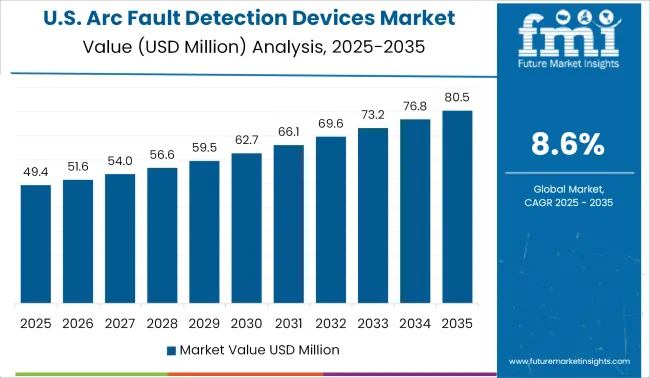
The global market of arc fault detection devices is presently dominated by North America as the region has already adopted this technology a long ago. United States is moving in a positive direction for electrical safety. Buildings such as hotels and retirement homes are adopting arc fault detection devices in large number for enhancement in safety.
Most of the key vendors are located in the North America region and have a high competition among the new players. There has been a significant reduction for electrical fault incidents in North America region. At the back of these factors, the AFDD market in the region will grow at a significant rate.
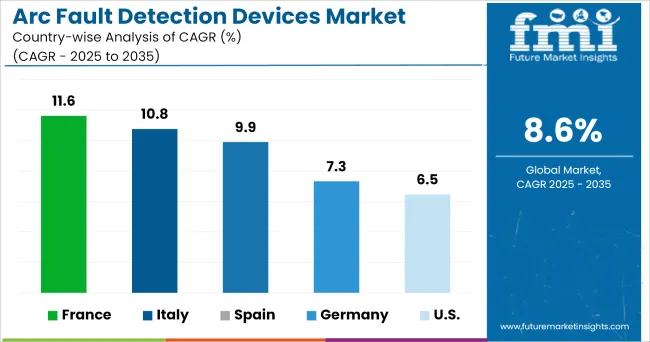
Residential homes, business and manufacturing businesses in Europe are moving towards the adoption of arc fault detection devices for enhancement in safety. Government and safety authorities are recognizing that defective electrical systems can pose a serious threat of fire risks to buildings and occupants.
So, they are focusing on AFDD for electrical installations in the UK for protection of persons, livestock and property against the risk from fires. This will further impel the expansion of AFDD solutions in Europe and drive the market demand during the forecast period.
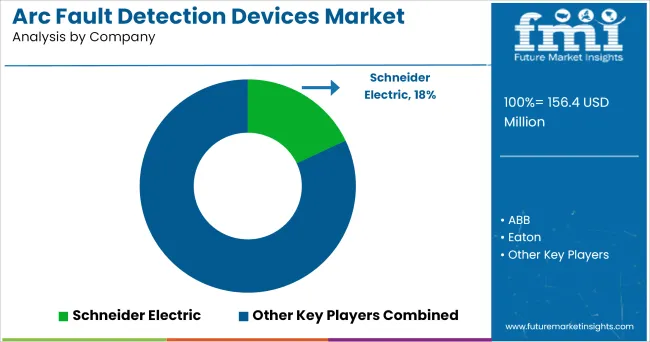
Some of the leading vendors of arc fault detection devices include
Key players in the market are focusing on expanding and deploying new lineup of arc fault detection devices solutions to meet rising demands from various end-user industries. These companies largely focuses on strategic acquisitions to broaden its product offerings.
The report is a compilation of first-hand information, qualitative and quantitative assessment by industry analysts, inputs from industry experts and industry participants across the value chain. The report provides in-depth analysis of parent market trends, macro-economic indicators and governing factors along with market attractiveness as per segments. The report also maps the qualitative impact of various market factors on market segments and geographies.
The global arc fault detection devices market is estimated to be valued at USD 156.4 million in 2025.
The market size for the arc fault detection devices market is projected to reach USD 356.9 million by 2035.
The arc fault detection devices market is expected to grow at a 8.6% CAGR between 2025 and 2035.
The key product types in arc fault detection devices market are 1 module, 2 module, 3 module and 4 module.
In terms of applications, residential segment to command 50.0% share in the arc fault detection devices market in 2025.






Full Research Suite comprises of:
Market outlook & trends analysis
Interviews & case studies
Strategic recommendations
Vendor profiles & capabilities analysis
5-year forecasts
8 regions and 60+ country-level data splits
Market segment data splits
12 months of continuous data updates
DELIVERED AS:
PDF EXCEL ONLINE
Arch Top Casement Window Market Size and Share Forecast Outlook 2025 to 2035
Arc Flash Risk Assessment Market Size and Share Forecast Outlook 2025 to 2035
Arch Top Door Market Size and Share Forecast Outlook 2025 to 2035
Architectural Metal Coating Market Forecast Outlook 2025 to 2035
Architectural Membranes Market Size and Share Forecast Outlook 2025 to 2035
Architectural Flat Glass Market Size and Share Forecast Outlook 2025 to 2035
Arc-based Plasma Lighting Market Size and Share Forecast Outlook 2025 to 2035
Arc Ferrite Magnet Market
Architectural Lighting Market
Barcode Scanner Market Size and Share Forecast Outlook 2025 to 2035
Parcel Insulation Market Analysis - Size and Share Forecast Outlook 2025 to 2035
Parchment Paper Market Size and Share Forecast Outlook 2025 to 2035
Parcel Delivery Vehicle Market Size and Share Forecast Outlook 2025 to 2035
Narcotics Scanner Market Size and Share Forecast Outlook 2025 to 2035
Garcinia Cambogia Extract Market Analysis - Size, Share, & Forecast Outlook 2025 to 2035
Carcinoid Tumor Syndrome Management Market Forecast & Analysis for 2025 to 2035
Barcode Printers & Consumables Market Growth - Trends & Forecast 2025 to 2035
Barcode Printers Market Growth - Trends & Forecast 2025 to 2035
Narcolepsy Treatment Market Growth – Trends & Industry Forecast 2024-2034
Barcode Labeller Machine Market

Thank you!
You will receive an email from our Business Development Manager. Please be sure to check your SPAM/JUNK folder too.
Chat With
MaRIA